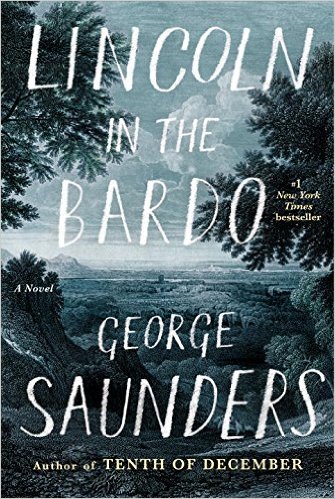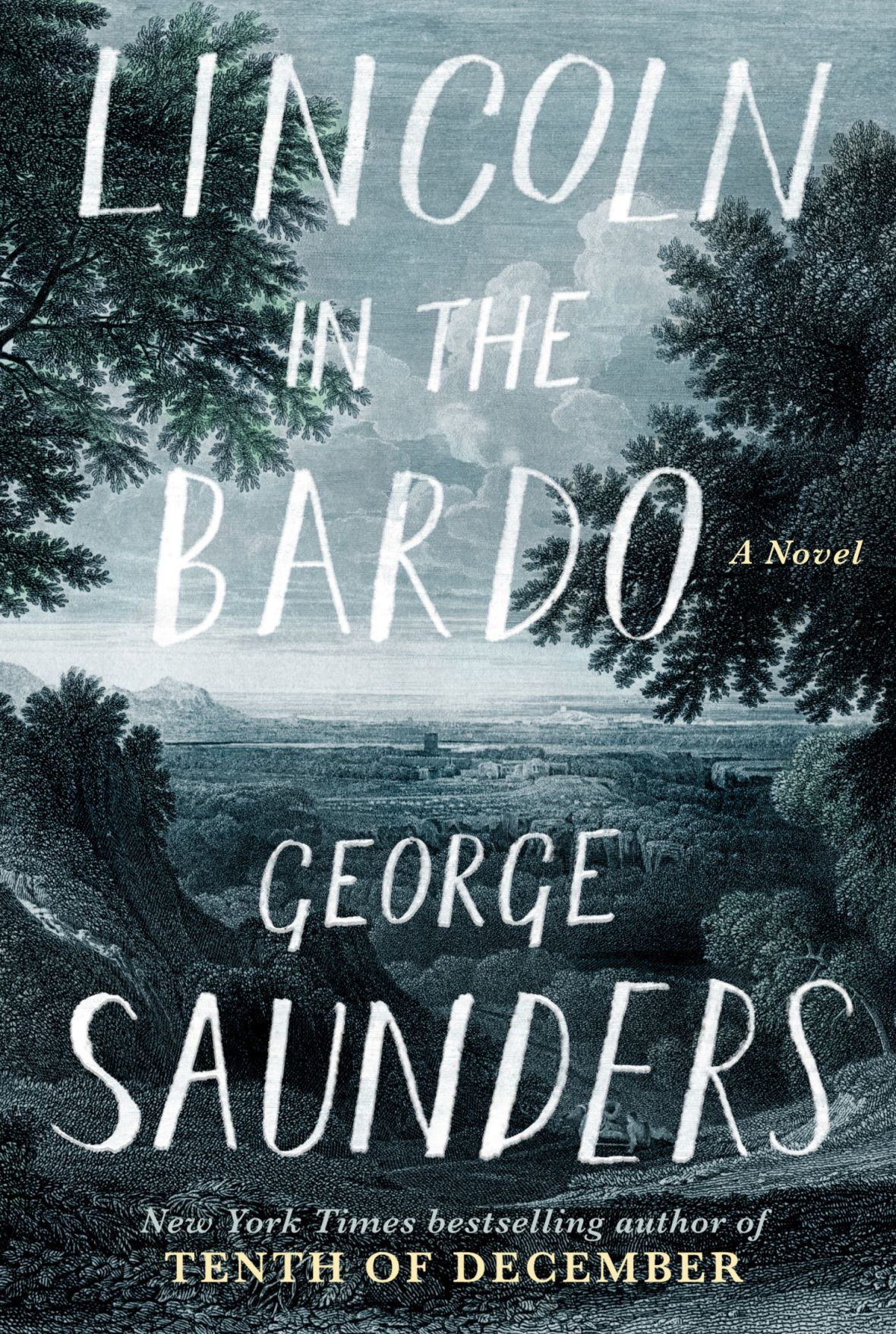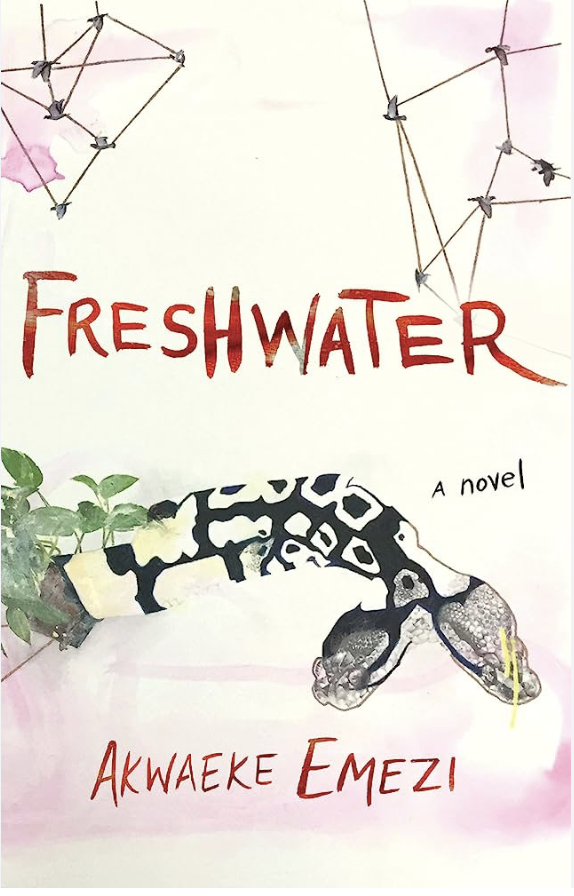Book by GEORGE SAUNDERS
Reviewed by SUSAN TACENT
 On February 20, 1862, Abraham and Mary Lincoln lost their eleven-year-old son Willie to what was probably typhoid fever. Some twenty years ago, George Saunders learned about a rumor that had circulated at the time—that Lincoln several times visited the crypt where Willie was temporarily interred, removed the body from its coffin and, in his great grief, cradled his dead child in his arms.
On February 20, 1862, Abraham and Mary Lincoln lost their eleven-year-old son Willie to what was probably typhoid fever. Some twenty years ago, George Saunders learned about a rumor that had circulated at the time—that Lincoln several times visited the crypt where Willie was temporarily interred, removed the body from its coffin and, in his great grief, cradled his dead child in his arms.
In a March 2017 article for The Guardian with the tagline “what writers really do when they write,” Saunders revealed that after hearing the rumor, “An image spontaneously leapt into my mind, a melding of the Lincoln Memorial and the Pietà. I carried that image around…too scared to try something that seemed so profound, and then finally, in 2012, noticing that I wasn’t getting any younger, not wanting to be the guy whose own gravestone would read ‘Afraid to Embark on Scary Artistic Project He Desperately Longed to Attempt,’ decided to take a run at it, in exploratory fashion, no commitments.”
The result is Lincoln in the Bardo, Saunders’ first novel after an illustrious career as a writer of short prose.
Every written work carries its own instructions-diction, syntax, choice of verb tense, even sentence length, all contain clues for how it wants to be read. This happens quickly. By the end of the first page, readers generally understand who is doing the talking, as well as where, when, and probably at least a bit about why.
Flip through the pages of Lincoln in the Bardo. It will become apparent immediately that this novel is different from most.
Rather than the usual quotes plus he said/she said formulation, you’ll find that speakers’ names, centered one line below in lower case letters, follow their utterances. And there are a great many. The audio version required the voices of one hundred and sixty-six people, some famous, some not. The novel’s hundred and eight chapters are counted in roman numerals, a formal gesture that seems somehow appropriate. The book has even already spawned a short virtual reality ‘film’ that brought Saunders to tears inside his VR headset (it’s available online and quite eerie, but read the book first).
Saunders also periodically deploys excerpts from a variety of historical sources. Clustered in their own chapters, some provide backstory, such as accounts of the dinner party the Lincolns gave the night Willie took a turn for the worse—“one moved dazed through a veritable bazaar of scents, colognes, perfumes, fans, hairpieces…” Some provide insight into characters, for instance, Willie—“A sunny child, dear & direct, abundantly open to the charms of the world.” Some describe the President’s face.
The ugliest man I have ever put my eyes on.
In “The Photographs of Abraham Lincoln,” by Frederick Hill Meserve and Carl Sandburg, account of Colonel Theodore Lyman.
The neighbors told me that I would find that Mr. Lincoln was an ugly man, when he is really the handsomest man I ever saw in my life.
In “Reminiscences of Abraham Lincoln by Distinguished Men of Hit Time,” by Allen Thorndike Rice.
And some describe the war:
I had never seen a dead person before. Now I saw my fill. One poor lad had frozen solid in the posture of looking down aghast at his wound, eyes open. Some of his insides had spilled out and made, there on his side, under a thin coat of ice, a blur of purple and red. At home on my dressing table was a holy card of the Sacred Heart of Jesus, and this fellow looked like that, only his bulge of red and purple was lower and larger and off to one side and him gazing down at it in horror.
In “That Terrible Glory: A Collection of Civil War Letters from the MenWho Fought It,” compiled and edited by Brian Bell and Libby Trust.
Dates and page numbers are omitted. It is left to the reader to decide whether to seek further information about the sources, including which are real. Real or not, their presence highlights the challenge: to create a novel around a deeply private loss suffered over a century ago by a very public figure.
Small wonder it took twenty years of rumination, and another four to write.
#
Bardo is a Tibetan word for the state between death and reincarnation, which can be loosely interpreted here to mean limbo. Lincoln in the Bardo takes place mainly in Georgetown’s Oak Hill Cemetery. It’s the winter of 1862. The cemetery has a robust population of ghostly residents from all walks of life—bachelors and soldiers, prostitutes and preachers, slaves and landowners. They’re in the bardo, stuck in the cemetery “because they’d been unhappy or unsatisfied in life.”
‘Life’ there has grown tedious. Says one resident,
We had sat every branch on every tree. Had read and re-read every stone. Had walked down (run down, crawled down, laid upon) every walk, path and weedy trail, had waded every brook; possessed a comprehensive knowledge of the textures and tastes of the four distinct soil types here; had made a thorough inventory of every hair-style, costume, hair-pin, watch-fob, stock-brace, and belt worn by our compatriots…
Along comes Willie Lincoln to shake things loose.
In writerly terms, if you’re looking to make something happen, bring in a stranger. Willie doesn’t know he’s dead. And he doesn’t know about the rule Saunders invented for this world: children who remain in the bardo instead of moving on will soon be trapped forever in a shell made of writhing souls that renders them violently, miserably insane. Three of the cemetery’s residents care enough to intervene. Just as they convince Willie to go, his father shows up, creating the obstacle that sets the plot on its track and cuts open the heart of the matter.
How do we survive the loss of a loved one?
During a talk he gave at Google in 2013, Saunders with typical wry humor raised a related question:
We know for a fact, totally verifiable–-that in X number of years we’ll all be rotting corpses somewhere. We know it. Why are we so happy? Why are we eating lunch? Or even to be a little more serious, we venture forth every day in love with somebody or somebody is beloved to us, and yet the incredible vulnerability that, you know, everyone comes to an end, including the people you love, for sure. So to me that, what’s weird is the habitual position of being OK with that. Yeah that’s true but you know my phone’s a little low on battery. It’s crazy really.
The cemetery’s ghostly residents have the ability to step into someone else’s body, dead or alive. In doing so, the ‘invader’ has access to the other’s thoughts and feelings, and, when inhabiting a living body, the physical sensations as well. It can be delightful. When his father joins him in the crypt, Willie for instance gets to experience how his father’s “long legs lay, how it is to have a beard, taste coffee in the mouth.”
Writers do this. Mingle, penetrate, enter into the characters on the page to make them live. But in Saunders’ cemetery, the living cannot sense or hear the dead. Homeric in majesty, heavy with grief, the scenes in the crypt between the bereaved president and his confused, frustrated boy carry the novel’s emotional heartbeat.
The man bent, lifted the tiny form from the box, and, with surprising grace for one so ill-made, sat all at once on the floor, gathering it into his lap.
roger bevins iii
Sinking his head into the place between chin and neck, the gentleman sobbed, raggedly at first, then unreservedly, giving full vent to his emotions.
the reverend every thomas
While the lad darted back and forth nearby, in an apparent agony of frustration.
hans vollman
The older residents of the bardo have never seen anything like this. “The holding, the lingering, the kind words whispered directly into the ear? My God! My God!” says one. “To be touched so lovingly, so fondly…” says another. “As if one were still worthy of affection and respect?” And it changes them, giving them hope that they were “perhaps not so unlovable as we had come to believe.”
The ghostly residents come out in droves and gather around the boy, hoping to learn something from him, wanting simply to be near him. Among them is Lieutenant Cecil Stone, a slaveowner and brutal rapist with a foul mouth, who refers to his slaves as SHARDS of COAL because they were “dark as night” and gave him “abundant Heat.”
In 1862, the Civil War was less than a year old and already had claimed many lives. It was clear it would claim many more. Lincoln was an unpopular president, in office for two years. Even as he struggles to find a way to let Willie go – for “Lincoln in the Bardo” refers to the living father as well as the deceased child – he tells himself he must figure out a way to “kill more efficiently” and “end suffering by causing more suffering.”
The question of how we survive the loss of a loved one widens to ask how one continues to lead a nation at war after experiencing firsthand the death of a son?
After Lincoln leaves the crypt, a group of angels makes one of their regular, sweeping passes through the cemetery, something the residents dread. Each angel appears “in a different guise” to each one. They are there to coax the residents into moving on. A few give in, but most stubbornly remain. Including Willie, whose troubles continue to grow: “…he had lost…approximately half his bodyweight. His cheekbones protruded; his shirt collar hung huge about his suddenly sticklike neck; charcoal-dark rings had appeared under his eyes.” There are signs that Willie’s eternal enslavement has begun.
Vollman and Bevins locate Lincoln, who is still in the cemetery, enter his body briefly, and discover they and Lincoln want the same thing for Willie: “We wished the lad to go, and thereby save himself. His father wished him to be ‘in some bright place, free of suffering, resplendent in a new mode of being’. A happy confluence of wishes.”
They formulate a plan to persuade Lincoln to return to the crypt, where they will encourage Willie to enter his father’s body again, with the hope that he’ll hear his father’s wish and move on. Plot and characters thus align, and if there’s anything far-fetched about this arrangement, it is mitigated by the fact that the characters themselves know they’re really reaching here, as they have no reliable “method by which to accomplish it.”
The president does return to the crypt, and in a moving and satisfying scene, Vollman and Bevins leave Lincoln’s body but remain inside one another long enough to experience each other’s true self, and be changed forever.
As word of Lincoln’s second visit spreads, hordes of ghostly residents swarm the crypt, confessing their sins, crimes, desires, and regrets. Lieutenant Stone leads a contingent of whites against blacks. The cemetery is soon in chaos. Interestingly Lincoln, still inside the crypt, can hear none of this.
Three source chapters follow. In the first, sources chart the anger and concern of the populace— “The Presdt is an idiot”; “We did not & will not Agree to fite for the Neygar, for whom we do not give a wit.” In the second, support for and disapproval of Lincoln’s parenting. In the third, judging the Lincolns for not cancelling the dinner party that took place when Willie was so sick.
This extended interruption of the main storyline serves in part as a delaying tactic. It ups tension, as the reader does not know whether this latest plan to get Willie to move on will work. It also reminds the reader of everything Lincoln was up against as he tried to find it in himself to accept his son’s death. The sources thus enter the reader in much the same way the cemetery’s residents enter the bodies of others.
Lincoln makes peace with the loss and is at last ready to go. His departure triggers a miraculous scene. As he walks away, one by one, driven by curiosity, wishing to be included, feeling brave, the ghostly residents by leaps and bounds enter the President’s body. Only Lieutenant Stone and his white contingent refuse to enter, “offended by the notion of proximity” to the black contingent.
Their loss.
Liberated from fear, resistance, selfishness, the others experience a clarity of common purpose, glimpses into one another’s minds as well as the president’s, and then a rush of individual happy memories from the time when they were alive. Thus fortified, then, one by one, they let go, move on, leaving the bardo at last.
Willie’s fate is also resolved, with some memorable slapstick antics and a lot of heart. But the novel reaches beyond the death of the small white boy.
That Google talk Saunders gave took place on February 20, 2013, exactly one hundred and fifty-one years after Willie Lincoln’s death. During the talk, Saunders revealed a goal he’d set for himself: “What I want to accomplish before I die is to try to make a fictional scale model of the world in which the positive and the negative, the hopeful and the not, are there in a kind of compelling mix.”
He accomplishes this with the help of Thomas Havens.
Thomas Havens is one of the black residents of the cemetery. Havens was a slave when he was alive. But since he was never “separated from my own wife or children,” since they “ate well, were never beaten…” and were given “a small but attractive yellow cottage” to live in, he reflects that it was “a happy arrangement, all things considered.” Yet he recalls a “little human voice, saying, you know: I wish to do what I wish to do, and not what you are telling me to do.”
Thomas Havens gets the last word. And the word is the most inclusive possessive pronoun possible.
Our.
A timely message, if ever there was one.
Susan Tacent has been published in Dostoevsky Studies, The Keats-Shelley Journal, The MacGuffin, Ontario Review, Blackbird, and DIAGRAM, among other journals. She has a story forthcoming in Michigan Quarterly Review. Her interview with Charles Baxter is on the Tin House Open Bar. She is putting final touches on Experience Points, her novel about a woman whose life changes after she discovers an MMORPG. Visit her blog at http://susantacent.weebly.com/blog.




